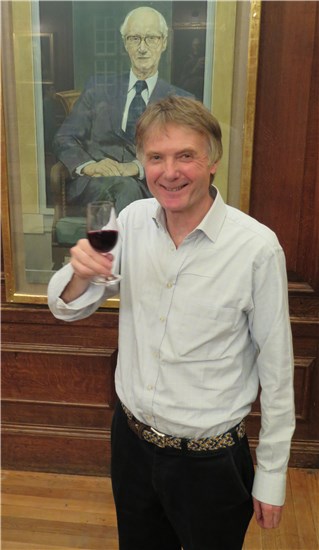 John Livingstone-Learmonth first visited the Rhône in 1973, and has since dedicated most of his life to writing and talking about the region’s wines - describing himself as ‘the oldest rocker in town’ in his LinkedIn profile. He is the author of four books on the Rhône, including The Wines of the Northern Rhône, which won the Louis Roederer International Book Prize in 2006, and runs the website drinkrhone.com. He is a Chevalier de l’Ordre du Mérite Agricole and an honorary citizen of the village of Châteauneuf-du-Pape.
John Livingstone-Learmonth first visited the Rhône in 1973, and has since dedicated most of his life to writing and talking about the region’s wines - describing himself as ‘the oldest rocker in town’ in his LinkedIn profile. He is the author of four books on the Rhône, including The Wines of the Northern Rhône, which won the Louis Roederer International Book Prize in 2006, and runs the website drinkrhone.com. He is a Chevalier de l’Ordre du Mérite Agricole and an honorary citizen of the village of Châteauneuf-du-Pape.
John explained his belief that balance, rather than intensity or concentration, is the quality that makes for great wines. Wines chosen for the tasting were made by young winemakers, and all reflected the passion, commitment and sureness of touch of their creators in their ‘hand-made’ quality.
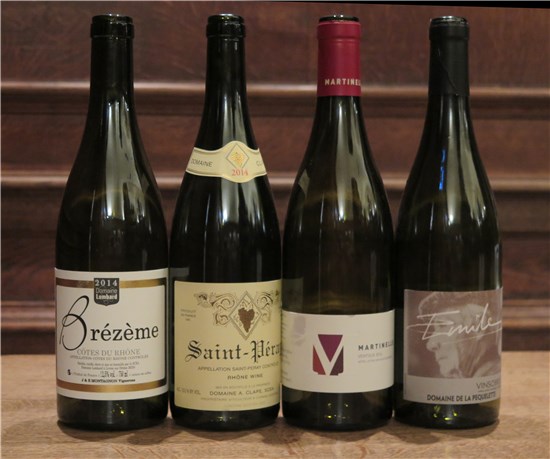 1. Brézème Côtes du Rhône, Domaine Lombard Blanc 2014 12.5% ABV (Yapp Bros, £18.95)
1. Brézème Côtes du Rhône, Domaine Lombard Blanc 2014 12.5% ABV (Yapp Bros, £18.95)
Brézème is a small area (less than 100 ha), granted AOC status in 1974, of which the long-standing 9 hectare Domaine Lombard family estate was run by Jean-Marie Lombard. Estate was taken over in 2011 by young Rhodanienne winemaker Julien Montagnon, who had been plying his trade in the Roussillon. He and his wife have constructed a state-of-the-art winery, and the whole domaine has been converted to organic status. The wine is crafted from an unusual blend of 80% Roussanne (20 year old vines), 12% Viognier and 8% Roussanne, which is barrel fermented in 600 litre oak casks (demi-muids) with regular batonnage. Pale gold, fresh, dainty and well-poised, this wine would make a good apéritif or an excellent accompaniment to steamed fish and poultry. It is best drunk within two years, and served lightly chilled.
2. St Péray, Domaine Clape 2014 13.5% ABV (Yapp Bros, £29.00)
This wine is the first vintage made by Olivier, the grandson of vigneron Auguste Clape, whose first vintage was in 1949. The wine is made with great respect for tradition, from a blend of 80% Marsanne and 20% Roussanne, one third of which is raised in oak foudres, one third in steel tanks and one third in cement vats for a minimum of 6 months prior to blending and bottling. It is the only white wine from the Domaine, and, with production of only 4000 bottles per annum, something of a rarity. The small vineyard is situated in higher, cooler foothills towards the Massif Central on the west bank of the Rhône between Cornas and St. Péray and 100 miles south of Brézème. The soil is mostly granite, with some clay, and. It has a richness and salty minerality, with apricots, peaches and honeysuckle on the palate and some nuttiness from the Marsanne. Medium-bodied and mouth-filling, this is a bright and stylish wine with a dry, persistent finish – traditional with a modern twist.
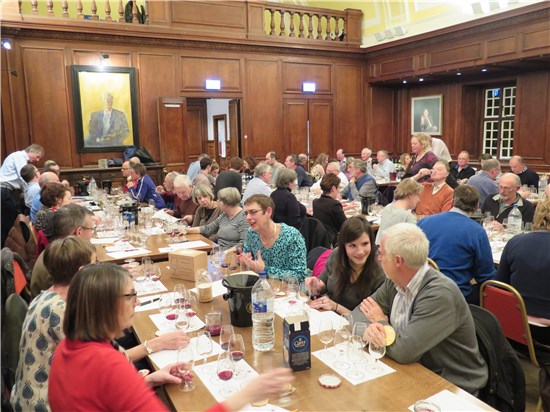 3. Ventoux, Martinelle 2014 14.5% ABV (Vine Trail, £11.50)
3. Ventoux, Martinelle 2014 14.5% ABV (Vine Trail, £11.50)
The vigneron at Domaine Martinelle is a woman: Corinna Kruze left Germany to pursue an ambition to make wine in the south of France and acquired her small group of vineyards on the edge of the Dentelles de Montmirail region in 2002. She now works the vineyards organically, and in 2009/2010 built her own simple and elegant wine cellar between the villages of Beaumes de Venise and Lafare. Her Ventoux is a blend of 70% Grenache, 25% Syrah and 5% Mourvèdre from vines grown on Triassic clay and limestone at an altitude of 300 metres. She is as non-interventionist as possible, using wild yeasts and minimum sulphur, and the wine is fermented and aged in concrete vats and bottled unfined and unfiltered. According to John it is very much a WOW wine (what one wants), fresh and beautifully integrated, perfumed, elegant and intense, with tremendous length of fruit, verve and drinkability. This is a wine to drink with almost anything – even fish. Delicious!
4. Vinsobres, Domaine de la Péquélette ‘Emile’ 2012 14.5% ABV (Vine Trail, £13.50)
Based in the cool, high-altitude Cotes du Rhone cru of Vinsobres, Cedric Guillaume-Corbin farms twenty-one acres in strict accordance with biodynamic principles. Formerly a winemaker for the Vinsobres Coop, Cedric-Guillaume founded his own winery some 20 miles north of Châteauneuf du Pape in 2005. His vineyards are situated on north-east facing slopes at an altitude of 400 metres, on limestone soils. The vines are cultivated biodynamically, and the wine is mostly Grenache (75%), with 10-14% Syrah, 8-10% Mourvèdre and 2-5% Carignan and Cinsault, fermented and aged in concrete tanks with no oak maturation. John remarked on the STGT quality of the wine (Soil to Glass Transfer), which embodies ‘the naked beauty of height and Vinsobres in a glass’. With aromas and flavours of raspberries and black cherries and a hint of liquorice, this is a bold and elegant wine with ‘freshness, truth and integrity’. Fruity, medium-to-full bodied, dense and velvety, it makes a perfect accompaniment to leg of lamb with rosemary and ‘dances on the toes of your foot – no heel involved’.
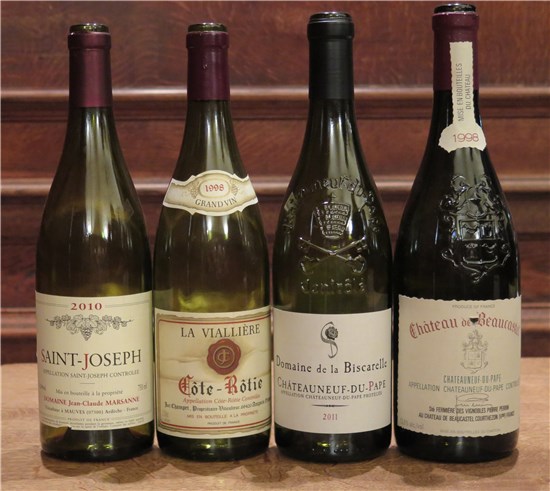 5. Saint-Joseph, Domaine Jean-Claude Marsanne 2010 13.5% ABV (Vineyards Direct, £15.95)
5. Saint-Joseph, Domaine Jean-Claude Marsanne 2010 13.5% ABV (Vineyards Direct, £15.95)
Jean-Claude Marsanne is a low-profile winemaker based near Tournon in the southern part of the Saint-Joseph appellation, who uses traditional methods to make a single cuvée of Saint-Joseph. His vineyards are based on granite soil, and his wine is made from 100% old vines Syrah – some dating back to the 1930s. It is fermented in stainless steel and matured in 600 litre oak casks – some new, some 2-10 years old. 2010 was an outstanding vintage, with perfect ripening conditions (a ‘solar’ vintage). The wine has a characteristic ‘steeliness’ and a ‘tailcoat of freshness’, with notes of pine needles and a hint of ‘boskiness’ (woody, shrubby character), and an abundant, ripe concentration of small berries. Deep red in colour, it has an impressive nose of wild berries, mulberries and liquorice. On the palate it is concentrated, with vibrant fruit, well-integrated tannins, fine balance and tremendous depth of flavour. Another STGT wine, this would pair well with red meat stews flavoured with thyme.
6. Côte Rôtie, Domaine Champet ‘La Viallière 1998 12.5% ABV (Yapp Bros, Library Stock)
Joël Champet took over 2 hectares of vines from his father Emile - whose habit was to taste from the cask at midday every day with a sugar lump - in 1985 and today farms 3 hectares with the assistance of his son Roman. The vineholdings of Champet Père et Fils lie in a single block in the Viallière vineyard, just to the North of Ampuis. Situated exclusively on the clay-based Côte Brune this is a traditional estate producing ‘single vineyard’ wine of great typicity. The wine is a blend of 95% Syrah with 5% Viognier, whole bunch fermented in concrete vats before spending 10 - 18 months in used oak. A product of the long, hot summer of 1998, it is fresh and violet-scented with red fruit flavours, earthiness and some tarriness, plus high tannins which are still present on the finish. A wine of moderate complexity and length that deserves food, JLL recommends drinking (decant first) with a ‘majestic veal chop, lots of garlic and rosemary and a reduced sauce’.
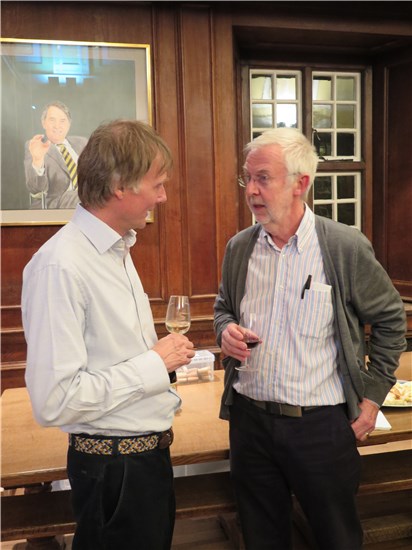 7. Châteauneuf-du-Pape, Domaine de la Biscarelle ‘Les Anglaises’ 2011 14.5% ABV (Vine Trail, £26.40)
7. Châteauneuf-du-Pape, Domaine de la Biscarelle ‘Les Anglaises’ 2011 14.5% ABV (Vine Trail, £26.40)
Gérard Bouyer founded La Biscarelle in 1984, after leaving his family’s négociant business to start his own venture. In January 2009, Gérard’s daughter and son-in-law, Christelle and Jérôme Grieco, took over the estate. The domaine owns five hectares in Châteauneuf-du-Pape, and the vineyards are located on the pebbly hills in the northern part of the appellation. Some of the parcels were planted more than a hundred years ago. Jérôme Grieco is one of the most hands-off winemakers in Châteauneuf, using whole clusters and fermenting his wines in cement tanks (the Syrah is fermented separately), and ageing in used French oak barrels for 12 months, which allows him faithfully to capture the expression of the terroir. The straight Châteauneuf-du-Pape is a very traditional bottling made from a Grenache-dominant blend which includes Mourvèdre, Cinsault, Syrah and Terret Noir. Unfined and unfiltered before bottling, it is smooth and spicy with flavours of sweet, ripe black raspberries. Lucid, clear, characterful and gloriously aromatic, this is a wine with immediate appeal and the power and bravado to age for a further five to eight years.
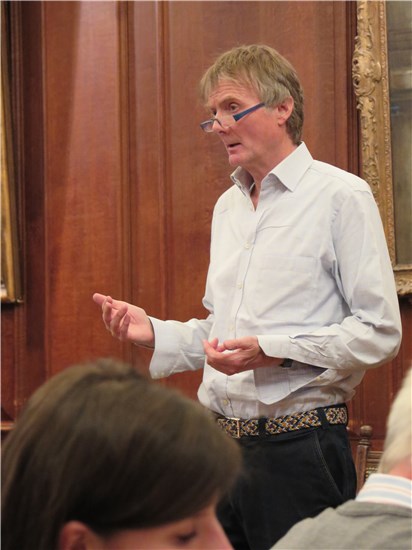
8. Châteauneuf-du-Pape, Château de Beaucastel 1998 13.5% ABV (Private stock, £38 approx)
Château de Beaucastel has 200 hectares of vineyards, making it one of the largest wine estates in the Châteauneuf du Pape region. Run by several generations of the Perrin family, beginning with the late Jacques Perrin (who died in 1978), then the brothers Jean-Pierre and Francois, it is now their sons Thomas, Marc, Pierre, and Mathieu who are in charge. Beaucastel was one of the very first domaines to practise organic viticulture – eschewing the use of herbicides, insecticides or any other chemicals. Unusually, all 13 permitted grape varieties are grown although it is Mourvèdre which is Beaucastel`s signature grape, often making up a third of the final blend – and indeed the Châteauneuf is a blend of 30% Grenache, 30% Syrah, 30% Mourvèdre and 10% other varieties, grown in sandy soils. It is matured in 500-litre oak casks and, after blending, bottled with a light fining and without being filtered. 1998 was a very hot year, producing small berries with thick skins and lots of integral tannin. The wine is of medium-to-full body, with pronounced tannins, low acidity and abundant blackberry fruit together with liquorice, black pepper, leather and earthy aromas and flavours. This is definitely a ‘gutsy’ food wine, and JLL recommends partnering it with robust game dishes. Drink within 5–8 years.
JLL commented that Châteauneuf had ‘lost its soul’ to Parker for many years, with winemakers tending to focus on dollar signs and ramping up prices to the detriment of the wines - which became too thick and dense. Happily the approach in more recent years has been toward more accessible wines – particularly the 2014 vintage, which although rainy, produced wines that positively ‘sing’.
CEB